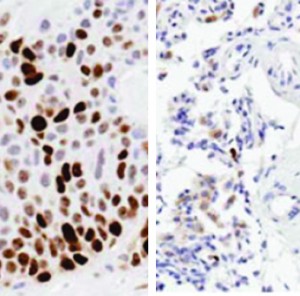
Compared to a control (left), mice treated with a chemotherapy drug using the device experienced significant tumor growth reduction as confirmed by the lack of brown staining.
Pancreatic cancer cells are notorious for being protected by a fortress of tissue, making it difficult to deliver drugs to either shrink the tumor or stop its growth. Now UNC researchers have developed a device that could change all that: By using electric fields, the device can drive chemotherapy drugs directly into tumor tissue, preventing their growth and in some cases shrinking them.
The work opens the possibility of dramatically increasing the number of people who are eligible for life-saving surgeries. It represents a fundamentally new treatment approach for pancreatic cancer, which has a 75 percent mortality rate within a year of diagnosis — a statistic that has not changed in more than 40 years.
“Surgery to remove a tumor currently provides the best chance to cure pancreatic cancer,” said Joseph DeSimone, Chancellor’s Eminent Professor of Chemistry at UNC and William R. Kenan, Jr. Distinguished Professor of Chemical Engineering at NC State University. “However, often a diagnosis comes too late for a patient to be eligible for surgery due to the tendency of the tumors to become intertwined with major organs and blood vessels.”
James Byrne, a member of DeSimone’s lab at UNC, led the research by constructing the device and examining its ability to deliver chemotherapeutic drugs effectively to pancreatic cancer tumors, as well as two types of breast cancer tumors. Read more.
